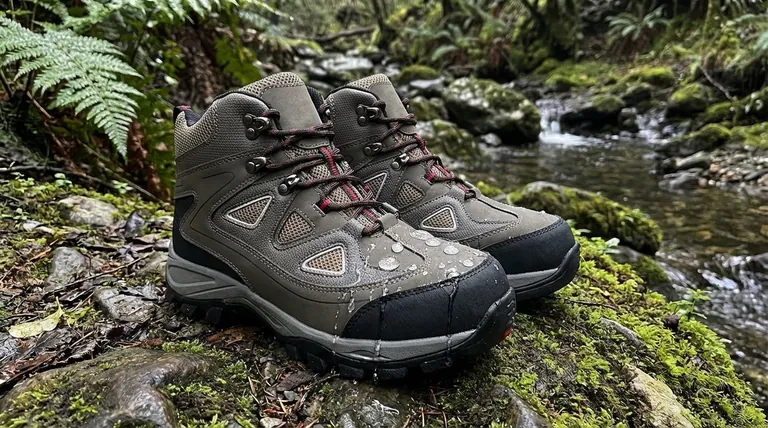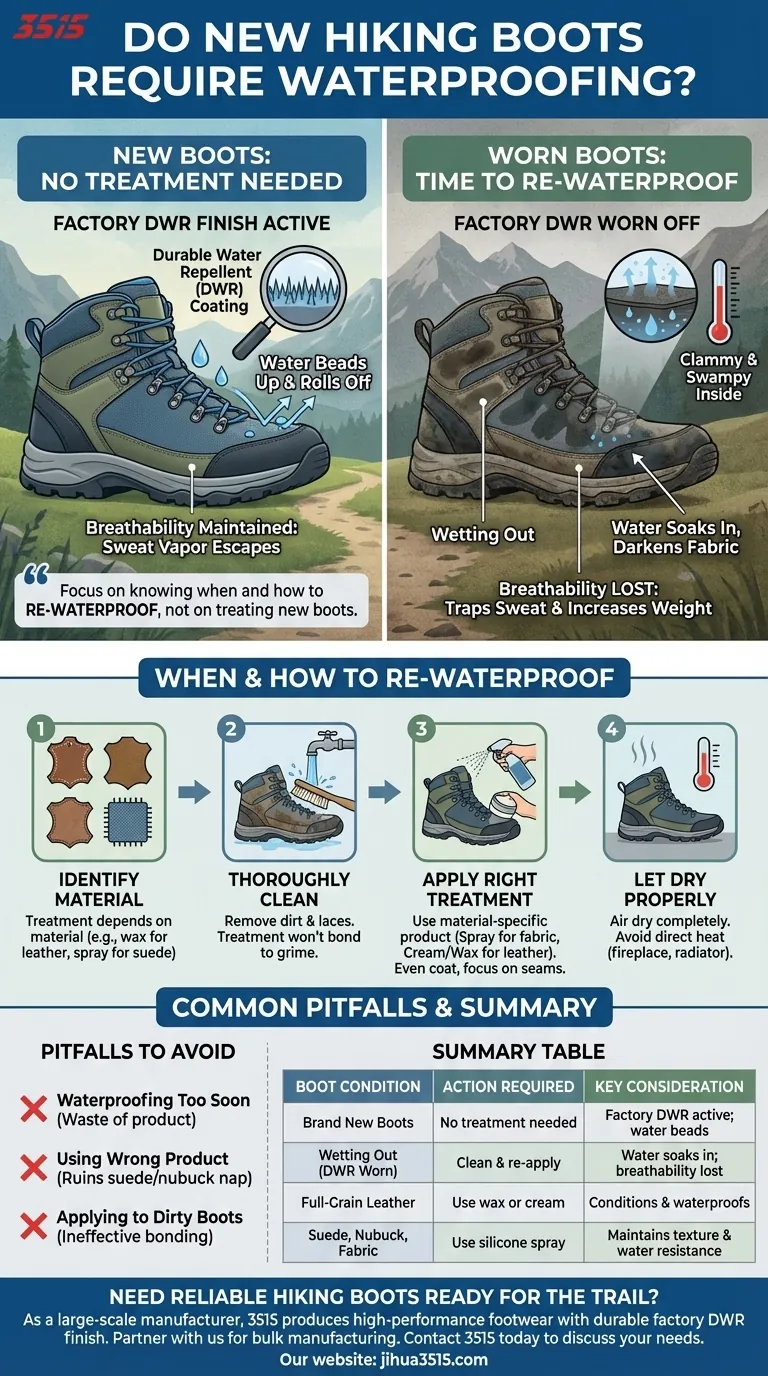In almost all cases, you do not need to waterproof new hiking boots. They arrive from the factory with a specialized coating called a Durable Water Repellent (DWR) finish. This initial treatment is designed to make water bead up and roll off the surface, providing more than enough protection for your first several adventures.
Your focus should not be on waterproofing your boots when they are new, but rather on knowing when and how to re-waterproof them once the factory finish inevitably wears off. This shift in perspective is the key to proper boot maintenance.

The Science of "New Boot" Protection
Understanding the Factory DWR Finish
A Durable Water Repellent (DWR) is a chemical treatment applied to the exterior of your boots. It works by creating a microscopic, spiky surface that increases the surface tension of water, causing droplets to form beads and roll away rather than soak in.
This DWR coating is your boot's first line of defense against moisture.
DWR's Role in Breathability
Many modern boots also feature an internal waterproof membrane (like Gore-Tex). The DWR finish is critical to helping that membrane function correctly.
When the DWR works, the boot's outer material stays dry, allowing water vapor (sweat) from inside to escape. If the DWR fails and the outer material becomes saturated—a state known as "wetting out"—the boot can no longer breathe effectively, trapping sweat and making your feet feel clammy.
The Telltale Sign of a Working DWR
The proof of a functional DWR finish is simple and visual. Sprinkle some water on your new boots. If it beads up into distinct droplets and rolls off easily, the factory treatment is working perfectly.
How to Know When It's Time to Re-Waterproof
The "Wetting Out" Test
You will know it is time to re-apply treatment when water stops beading on the surface. Instead of rolling off, the water will absorb into the outer fabric, often darkening its color.
This absorption is the definitive sign that the original DWR has worn down due to abrasion, dirt, and general use.
Why "Wetting Out" Matters
Even if your boots have a waterproof membrane that keeps your feet dry, a wetted-out boot becomes heavier and loses all breathability. This leads to that uncomfortable, swampy feeling inside your boot, which can contribute to blisters and discomfort on the trail.
The Correct Re-Waterproofing Process
Step 1: Identify Your Boot's Material
Before you buy any product, determine what your boots are made of. The correct treatment depends entirely on the material.
Common types include full-grain leather, nubuck, suede, or a synthetic fabric/leather combination. Each requires a specific type of waterproofing agent.
Step 2: Thoroughly Clean Your Boots
Never apply a waterproofing treatment to dirty boots. Dirt and grime prevent the treatment from bonding properly with the material, rendering it ineffective.
First, remove the laces. Then, use a soft brush to remove all loose dust and dirt. For a deeper clean, use running water and a dedicated boot cleaner.
Step 3: Choose and Apply the Right Treatment
Select a product specifically designed for your boot's material. Treatments for full-grain leather (often waxes or creams) are different from those for suede, nubuck, or fabric (typically sprays).
When using a spray, hold the can about six inches from the boot and apply an even coat. Pay special attention to seams, creases, and the area around hardware, as these are common failure points.
Step 4: Let Them Dry Properly
After application, allow your boots to air dry completely in a well-ventilated area away from direct heat sources. Heat from a fireplace or radiator can damage the leather and adhesives.
Common Pitfalls to Avoid
Mistake: Waterproofing Too Soon
Applying a new treatment on top of a functional factory DWR is unnecessary. It adds no benefit, can sometimes affect the material's breathability, and is a waste of product and money.
Mistake: Using the Wrong Product
This is the most critical error. Using a heavy wax-based product on suede or nubuck boots will ruin their soft, textured finish (the "nap") and can permanently alter their appearance and breathability. Always read the product label.
Mistake: Applying to Dirty Boots
As mentioned, this is a recipe for failure. The waterproofing treatment will stick to the dirt, not the boot, and will wear away almost immediately, leaving you with no protection.
Making the Right Choice for Your Boots
Your maintenance strategy should be guided by your boot's condition and material, not a predetermined schedule.
- If you have brand new boots: Trust the factory DWR finish and simply focus on brushing them clean after your hikes.
- If you notice water soaking into the outer material: It is definitively time to clean your boots thoroughly and re-apply the appropriate waterproofing treatment.
- If your boots are made of full-grain leather: Choose a wax or cream-based treatment when re-applying to condition the leather and provide robust water resistance.
- If your boots are made of suede, nubuck, or fabric: Use a silicone-based spray treatment to maintain water resistance without damaging the material's texture.
Proper maintenance is not about frequent treatment, but timely and correct application to ensure your boots perform for years to come.
Summary Table:
| Boot Condition | Action Required | Key Consideration |
|---|---|---|
| Brand New Boots | No treatment needed | Factory DWR finish is active; water should bead up |
| DWR Worn Off (Wetting Out) | Clean and re-apply waterproofing | Water soaks in, darkening material; breathability is lost |
| Full-Grain Leather Boots | Use wax or cream-based treatment | Conditions leather while providing water resistance |
| Suede, Nubuck, or Fabric Boots | Use silicone-based spray | Maintains water resistance without damaging texture |
Need Reliable Hiking Boots That Are Ready for the Trail?
As a large-scale manufacturer, 3515 produces a comprehensive range of high-performance footwear for distributors, brand owners, and bulk clients. Our boots are built with quality materials and arrive with a durable factory DWR finish, ensuring your customers hit the trail with confidence.
Our production capabilities encompass all types of hiking boots and shoes, designed for durability and comfort. Partner with us to supply footwear that meets the demands of outdoor enthusiasts.
Contact 3515 today to discuss your bulk footwear needs and discover how our manufacturing expertise can benefit your business.
Visual Guide

Related Products
- Safety Footwear Wholesale Manufacturer for Custom OEM/ODM Production
- Wholesale High-Traction Camo Boots - Custom Manufacturer for Brands
- Factory-Direct Wholesale Canvas Boots with High-Traction Rubber Soles
- High Performance Fire-Retardant Waterproof Safety Boots
- Factory Direct Wholesale Rain Boots Durable Waterproof & Fully Customizable
People Also Ask
- How do safety shoes contribute to cost savings for companies? A Strategic Investment in Risk and Cost Management
- Is safety-toe as good as steel toe? Choose the Right Protection for Your Job
- What are the differences between steel toe, composite toe, and alloy toe Wellington boots? Choose the Right Safety Toe for Your Job
- What are OSHA approved shoes? Understanding the Correct Standards for Workplace Safety
- How long can you wear safety boots? The Lifespan is Determined by Wear, Not Time



















